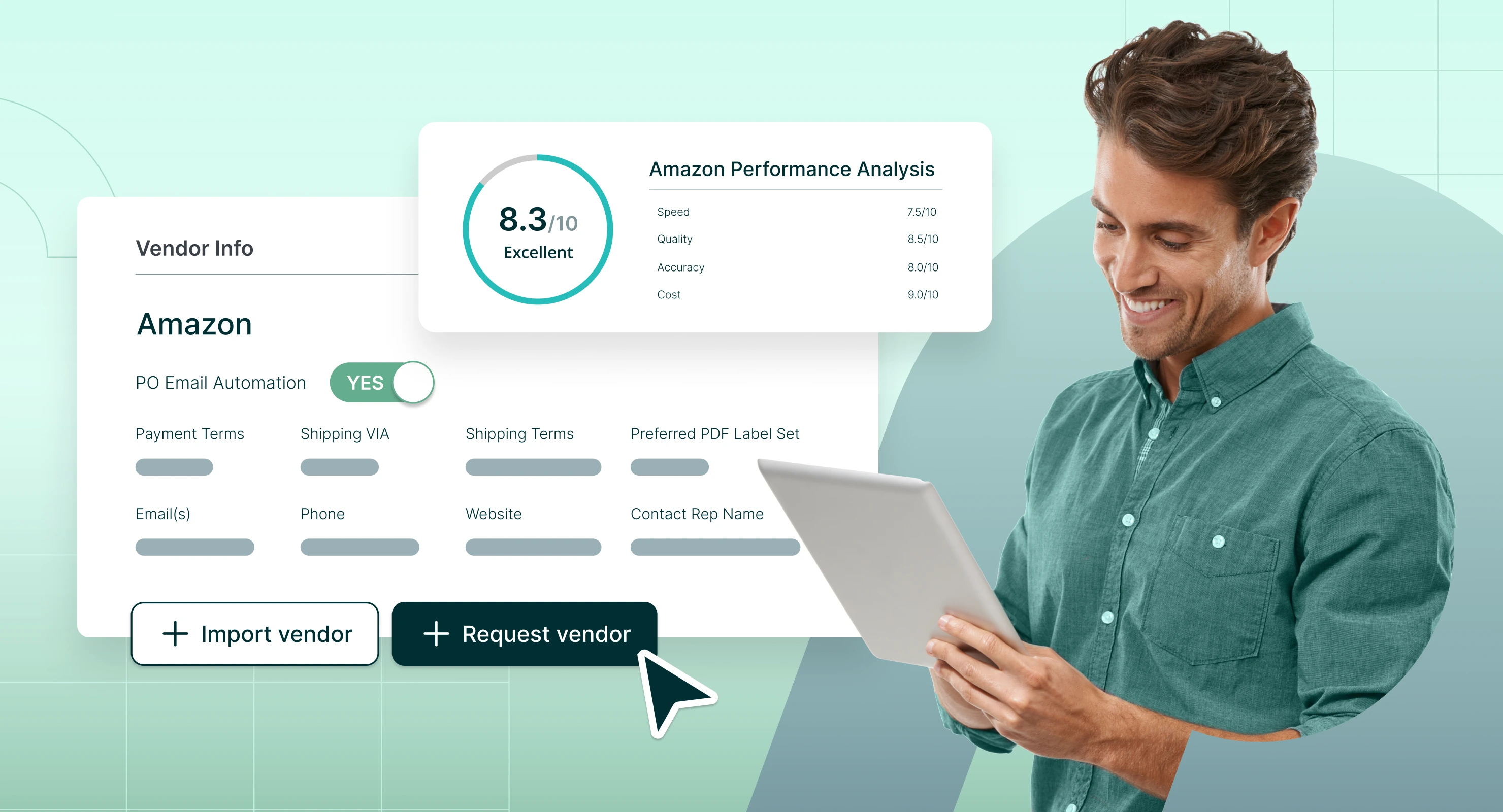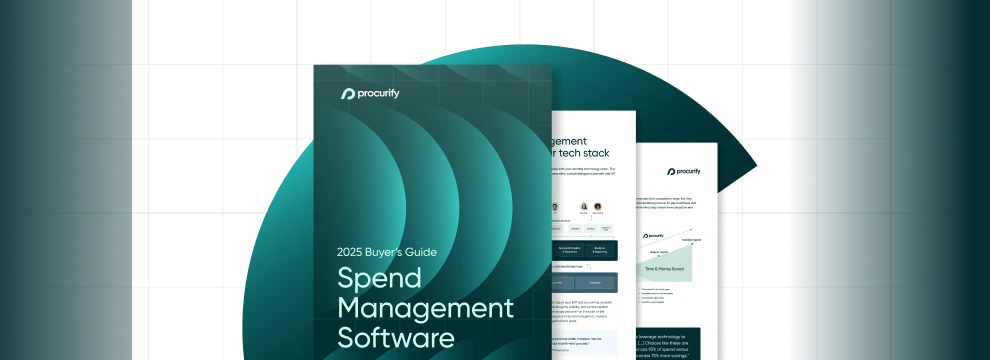
Best Vendor Management Software for 2025
The best vendor management software in 2025 helps businesses navigate growing supplier networks, regulatory requirements, and rising cost pressures.
As procurement teams adopt AI and automation powered solutions, vendor management has become central to operational success. A strong vendor management system (VMS) centralizes vendor data, streamlines workflows, and provides real-time performance insights—allowing organizations to control risk, ensure compliance, and build stronger supplier relationships.
With the vendor management software market projected to grow at a 12.3% CAGR through 2030, fueled by AI innovation, cloud adoption, and sustainability demands, choosing the right solution is now a strategic priority.
In this guide, you’ll learn what a vendor management system (VMS) is, explore the leading software solutions of 2025, uncover the trends reshaping vendor management, and see how Procurify helps organizations stay ahead.
Best Vendor Management System (VMS): Definition, Features, and Benefits
A vendor management system (VMS) is software designed to simplify and optimize the management of supplier relationships. From onboarding new vendors to tracking performance and ensuring compliance, a VMS acts as the backbone of a streamlined procurement process.
Key components of a VMS
-
Vendor onboarding and qualification: Automates the collection of vendor details, ensuring all necessary certifications, tax information, and compliance documents are gathered before a vendor is approved.
-
Contract and agreement management: Centralizes contracts to track key dates, terms, and renewals, reducing the risk of lapses or missed obligations.
-
Performance monitoring: Provides analytics and dashboards to measure vendor KPIs such as delivery timelines, product quality, and service efficiency.
-
Risk mitigation: Tracks vendor compliance and flags risks, such as expired certifications or underperformance, allowing for proactive management.
-
Integration with other systems: A VMS seamlessly integrates with procurement, accounting, and enterprise resource planning (ERP) systems to provide a cohesive procurement ecosystem.
The role of a VMS in modern businesses
In 2025, businesses rely on VMS not just for efficiency but also to meet regulatory standards and customer expectations. A strong VMS provides transparency into vendor operations, ensuring all partners align with an organization’s ethical, operational, and financial goals.
Key benefits of vendor management software
The adoption of a VMS offers a broad spectrum of advantages, making it a game-changer for organizations of all sizes.

-
Centralized vendor data
- Maintain a single source of truth for all vendor-related information, accessible to all stakeholders.
- Reduce silos and eliminate duplicate or outdated vendor records.
-
Cost savings
- Optimize vendor performance to minimize delays, rework, and quality issues.
- Leverage analytics to consolidate vendors and negotiate better terms.
-
Improved risk and compliance management
- Automate compliance checks to ensure vendors meet local, national, and industry-specific regulations.
- Identify risks early using alerts for expiring documents, missed deadlines, or financial instability.
-
Better vendor relationships
- Promote transparency with vendors through shared dashboards and performance reports.
- Build long-term partnerships by identifying and rewarding top-performing vendors.
-
Operational efficiency
- Streamline procurement workflows, from request to payment, using automation.
- Free up teams to focus on strategic initiatives rather than manual administrative tasks.
What to look for in top vendor management solutions
Selecting the best vendor management software means focusing on features that directly support your organization’s efficiency, compliance, and scalability.
Here are the capabilities to prioritize in 2026:
Vendor centralization
A strong platform consolidates all vendor information—contracts, certifications, communications, and payment histories—into one accessible repository. This reduces silos and ensures every team has the same source of truth.
Workflow automation
The right system automates repetitive tasks that slow down procurement, such as:
- Purchase order approvals
- Invoice matching
- Contract renewals
- Automation not only saves time but also reduces errors and compliance risks.
Real-time reporting and analytics
Advanced analytics should deliver actionable insights, such as spend by vendor, delivery performance, and areas for cost reduction. Customizable dashboards help align procurement with broader business KPIs.
Punchout catalog integration
Modern vendor management platforms increasingly include punchout functionality, enabling buyers to access supplier catalogs directly within the procurement system. Punchout streamlines purchasing, ensures up-to-date pricing, reduces manual entry, and strengthens compliance with preferred vendors. Learn more about punchout catalogs here.
Integration with key systems
A VMS should integrate seamlessly with ERP and accounting platforms like QuickBooks, NetSuite, and Sage Intacct to avoid duplicate data and maintain accuracy across financial systems.
Scalability and customization
As your business grows, the VMS should expand with it. Look for solutions that allow you to add vendors, users, and workflows without disruption, while also supporting custom configurations that match your unique processes.
Top 8 best vendor management software solutions for 2025

How to choose the right vendor management system
Selecting the best vendor management system (VMS) is a strategic decision that directly affects efficiency, compliance, and vendor relationships. Rather than treating the choice as a software purchase, think of it as selecting a long-term partner for your vendor procurement strategy. Here’s a streamlined framework to guide your evaluation:
1. Define Your Needs
Procurement complexity: Consider the number and diversity of vendors—local suppliers vs. a global network.
Industry requirements: Identify compliance needs such as certifications, audits, or regulations (e.g., healthcare or pharmaceuticals).
Key challenges: Pinpoint issues like manual workflows, communication gaps, or compliance risks that the system must address.
2. Evaluate Core Features
- Automation: Streamline tasks such as approvals, compliance checks, and payment processing.
- Data centralization: Consolidate vendor records, contracts, and performance metrics into a single repository.
- Reporting & analytics: Look for customizable dashboards that tie directly to your procurement KPIs.
3. Assess Scalability
- Ensure the system can grow with your business, adding users or vendors without major disruption.
- Check for flexible workflows that adapt to changing processes.
4. Check Integration Capabilities
- Confirm compatibility with ERP platforms (NetSuite, Sage Intacct, Microsoft Dynamics 365).
- Ensure smooth connections with accounting tools like QuickBooks.
- Look for links to procurement software for requests, approvals, and budgets.
5. Analyze Total Cost of Ownership (TCO)
- Upfront costs: Licensing or subscription fees.
- Implementation costs: Resources needed for setup.
- Ongoing costs: Maintenance, upgrades, and user training.
6. Review Vendor Support and Reputation
- Does the provider offer 24/7 support?
- Review testimonials and customer case studies.
- Ask for references from organizations similar to yours.
7. Test Before Committing
- Take advantage of demos or trials.
- Assess usability, speed, and fit with your workflows.
- Involve key stakeholders to validate performance.
Trends in the vendor management software market for 2025
The vendor management landscape in 2025 is evolving rapidly, driven by technological advancements, regulatory changes, and shifting business priorities. Here are the top trends shaping the VMS market:
-
AI-powered vendor insights
- Predictive analytics: AI algorithms analyze historical data to predict vendor risks, such as late deliveries or compliance lapses.
- Automated scoring: Systems now provide real-time vendor scorecards based on performance, quality, and responsiveness.
- Procurify’s AI integration: By integrating AI, Procurify empowers businesses with smarter decision-making tools, allowing proactive management of vendor risks.
-
Sustainability and ESG (environmental, social, and governance) compliance
As ESG priorities grow, businesses are under pressure to ensure their vendors align with sustainability goals:
- Carbon footprint tracking: Systems now track vendors’ environmental impact.
- Ethical sourcing verification: Tools ensure vendors meet labor and sourcing standards.
- Market insight: Gartner reports that by 2026, 60% of companies will include ESG metrics in their vendor evaluation process.
-
Cloud-based solutions dominate
- Accessibility and scalability: Cloud VMS platforms provide real-time access and are easily scalable for businesses of all sizes.
- Reduced costs: Cloud solutions eliminate the need for costly on-premise infrastructure.
- Security enhancements: Cloud platforms now offer advanced security features, such as encrypted vendor data storage and multi-factor authentication.
-
Vendor collaboration platforms
- Interactive portals: Vendors and businesses can now collaborate through shared portals for better communication and transparency.
- Procurify’s vendor collaboration tools: Procurify simplifies vendor engagement by providing centralized platforms for tracking performance and communication.
-
Embedded financial services
- Integrated payments: Modern VMS solutions streamline vendor payments directly through the platform, reducing processing time and errors.
- Procurify feature: Procurify offers bill payment solutions that integrate directly with your accounting software for seamless financial workflows.
7. Vendor management software market overview
The vendor management software market is poised for significant growth in 2025, with increasing adoption across industries such as healthcare, manufacturing, retail, and finance. Here’s a closer look at the market landscape:
-
Market size and growth
- According to Mordor Intelligence, the vendor management software market was valued at $3.8 billion in 2022 and is expected to reach over $6.5 billion by 2028, growing at a CAGR of 12.3%.
- Growth drivers include:
- The rise of remote and distributed teams requiring centralized vendor oversight.
- Increased regulatory pressures driving demand for compliance management tools.
-
Key players and market share
- Dominant players in the market include Procurify SAP Ariba, Coupa, and GEP SMART. Procurify stands out by focusing on ease of use, affordability, and integrations tailored to small and mid-sized businesses.
-
Regional trends
- North America: The largest market, driven by technology adoption and a strong focus on regulatory compliance.
- Europe: Growing interest in ESG compliance has boosted VMS adoption in sectors like retail and energy.
- Asia-Pacific: Rapid industrialization and supply chain complexity are fueling demand for vendor management solutions.
-
Future outlook
- AI and automation: By 2030, AI-driven vendor management tools are expected to account for 40% of market solutions.
- Focus on SMEs: Small and mid-sized enterprises are adopting VMS platforms to remain competitive and agile in a dynamic market.
Next Steps
Whether you’re managing 15 vendors or 500, scaling without modern vendor management software (VMS) is nearly impossible.
With 2026 approaching, now is the time to embrace AI and automation to strengthen your supplier strategy. Procurify gives businesses intuitive tools to centralize vendor data, streamline workflows, and unlock actionable insights.
Ready to see it in action? Take a self-guided product tour and explore how Procurify can simplify vendor management for your team.
